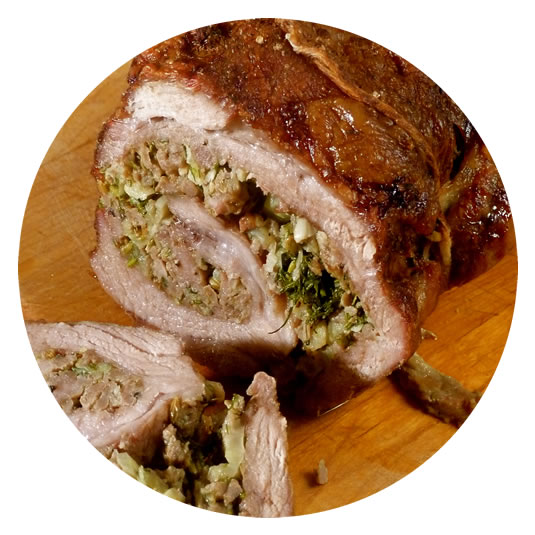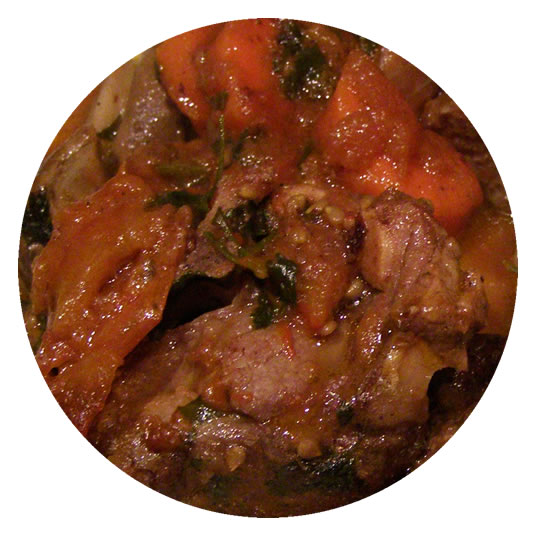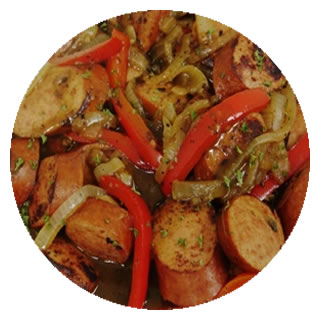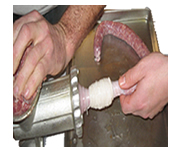|
 Pork Recipes! Pork Recipes!
Beef, veal, chicken, pork, lamb and rabbit are the standard recipes that we will be looking at.
It seems that veal dishes figure predominantly in all the fine Italian dining establishments. There are two types of veal. Milk fed which is very tender and slightly more expensive then grain fed veal. You pay for what you get.
A little secret. My husband owned a gourmet italian restaurant in the early nineties and learned one important thing amongst his best chefs. A small ingredient that kept going into all the meat dishes. The name of this ingredient is Demi-Glace. Add a little to every meat dish for a five star taste.
If you have a great Pork recipe, please share with us. If you have questions regarding this recipe page, please fill out our online contact form and it will be our pleasure to respond. ♥ The Italian Cook
Italian Pork Roast (Porchette)
|
| |
Pork Roast (Porchetta)
 Ingredients: Ingredients:
1 Boston Butt Pork Roast
1 large clove garlic, cut longway into 8 slivers
4 large sprigs fresh rosemary, leaves only
salt and pepper
Directions:
Step One: Prepare the roast
1• Using a sharp paring knife, cut 8 evenly spaced deep crosses in the roast.
2• Place a garlic sliver in each and push to the bottom with your finger, forming a small pocket.
3• Into each pocket, pushing with your finger, put equal amounts of salt (first) and pepper (last).
4• Using a sharp paring knife, cut 8 evenly spaced deep crosses in the roast. The pocket should be loosely filled.
5• Divide the rosemary leaves into 8 equal piles and firmly plug each of the holes.
6• Give a generous sprinkle of salt and pepper over the entire roast.
Step Two: Cook the roast
1• Insert a meat thermometer into the thickest part of the roast to the center. Be careful not to have the tip of the thermometer touching a bone.
2• Place the roast in a shallow baking pan and put in a medium oven (325-350). Remove the roast when you have an internal temperature of 170-175 degrees.
3• Roasting time will vary, depending on the exact temperature of the oven, and if the roast is at room temperature or just out of the refrigerator. Let roast stand for 10 to 15 minutes to firm up a bit before serving.
This method of seasoning and cooking a pork roast will also work well with a whole fresh picnic ham (front shoulder), or a fresh ham (rear). The seasoning method also works well with a whole bone-in or boneless pork loin, however, the cooking should be changed to a very slow roast (225 degrees) and a finished internal temperature of 135-140 degrees.
Leftovers from roasts done in this style make a delicious cold pork sandwich. Thinly slice a nice stack of the cold pork roast, place on a slice of homemade bread, top with a seeded, split banana pepper, and spread a little yellow mustard on the top slice of bread.
|
|
| |
Pork Stew with Eggplant
 Ingredients: Ingredients:
2 tbsp Extra Virgin Olive Oil 30 mL
1 lb lean,boneless pork, cubed 500 g
2 onions, sliced
1 can (28 oz/796 mL) San Marzano tomatoes
2 cups cubed peeled eggplant 500 mL
1 cup canned Pitted Olives, 250 mL sliced
salt and pepper
Directions:
1• Preheat oven to 3 0 °F (180 °C).
2• Heat olive oil in a skillet over medium-high heat. Add pork and brown on all sides.Add onions and cook for
3• minutes.Season to taste with salt and pepper.
4• Transfer mixture to a casserole or baking dish with a cover. Stir in tomatoes and eggplant.Bake in oven about 1 hour.
5• Stir in black olives. Bake another 15 minutes and serve immediately. Swiss chard makes a nice accompaniment.
4 servings
|
|
| |
Pork Marsala with Olives
 Ingredients: Ingredients:
1 3/4 pound cubed pork
6 ounces calamata black olives
1 can (28 oz/796 mL) San Marzano tomatoes
2 cloves garlic, minced
fresh rosemary
3/4 cup red wine
3/4 cup dry Marsala
3 tablespoons olive oil
Salt and pepper to taste
Directions:
1• Sauté the garlic and the rosemary in the olive oil, and once the garlic has turned slightly dark add the pork.
2• Brown everything, then stir in the Marsala and the wine and cook high until they have evaporated.
3• At this point stir in the tomatoes, a cup of hot water, and the calamata olives, and season to taste with salt and pepper.
4• Lower the heatm, simmer and cook for an hour and a half, by until the sauce is fairly thick.
Serves 8.
|
Pork Sausage and Vegetables
|
| |
Pork Sausage and Vegetables
 Ingredients: Ingredients:
2 lb. Italian link sausage (mild or strong or both)
1 can (28 oz/796 mL) San Marzano tomatoes
1 large green bell pepper, sliced into thick strips
1 large red bell pepper, sliced into thick strips
4 large potatoes, sliced
6 large mushrooms, sliced
1 large onion, sliced
1 tsp. garlic powder
1 tsp. fresh basil
1 tsp. dried oregano
Directions:
1• Prepare a roasting pan on the side to recieve the following cooking steps:
2• In a frying pan cook the italian sausages in olive oil until browned. Add to roasting pan
3• In a frying pan cook the green and red peppers in olive oil until browned. Add to roasting pan
4• In a frying pan cook the potatoes in conola oil until browned. Add to roasting pan
4• In a frying pan cook the onions and mushrooms in olive oil until browned. Add to roasting pan
5• Once the ingredients above are all in the roasting pan blend in all the herbs and spices let sit and when ready to serve put it in the oven for 15 minutes at 350 F.
Serves 4.
 Print this recipe - Pork Sausage and Vegetables Print this recipe - Pork Sausage and Vegetables
|
TPork Style Italian Sausage (Hot) - Salsiccia Recipe
|
| |
Pork Style Italian Sausage (Hot)
 Ingredients: Ingredients:
• 20 lbs. trimmed pork butt4 lbs. cubed pork fat back
• 4 lbs. cubed pork fat back
• 8 Tblsp. salt
• 5 Tblsp. coarse ground black pepper
• 5 Tblsp. ground coriander
• 16 large garlic cloves, minced
• 8 Tblsp. crushed red pepper flakes
• 1 cup paprika
• 2 cups dry white wine
• Approximately 30 feet of casings
Preparation:
While no recipe should ever be "written in stone" I would caution you about reducing the amount of fat below what is indicated. After much experimentation this ratio of fat to meat is the smallest you can use and still have a moist and succulent sausage. Alter the seasonings to fit your taste, but remember that salt is a necessary preservative, even in a cooked final product. Fatback can be ordered from your butcher or meat distributor. This is a very dense, smooth fat used in making patés as well as sausage. By trimming the meat first you discard most all of the original fat, then add back in the correct amount of more desirable fat. This serves two purposes. First, it allows you to control the ratio of meat to fat; and second, it replaces the lower quality, loose fat on the meat which tends to gum up the blades of your grinder and stuffer. There are two schools of thought on this matter. One side does it the way I've explained and the other chooses to go with the fat that is on the pork butt and not trim it or add fresh fatback.
You can use either a table top meat grinder (with sausage stuffing attachment) or the meat grinder and sausage horn attachment to an electric mixer such as the Kitchen Aid. For both of these recipes you would use the medium or coarse plate.  The casings are available through wholesale meat distributors or any good butcher will special order them for you. I prefer a natural hog casing which is purchased by "the hank". A hank of casings will make at least 150 pounds of sausage. Cost will run around $15 to $18 dollars, they will arrive heavily salted, and should keep in the refrigerator for at least six months. If you prefer not to use casings, the sausage can be formed into patties and be perfectly delicious if not as versatile in their use. If you do use the casings, allow a generous foot per pound. The casings are available through wholesale meat distributors or any good butcher will special order them for you. I prefer a natural hog casing which is purchased by "the hank". A hank of casings will make at least 150 pounds of sausage. Cost will run around $15 to $18 dollars, they will arrive heavily salted, and should keep in the refrigerator for at least six months. If you prefer not to use casings, the sausage can be formed into patties and be perfectly delicious if not as versatile in their use. If you do use the casings, allow a generous foot per pound.
To prepare casings: Measure off the amount of casings you will need for your recipe, being generous in your measurements in case of a tear. Soak in cold water for 15 minutes. Meanwhile clean and rinse the end of your kitchen tap (remove any aerator you may have there). Take the end of the casing and fit it onto the tap then turn the cold water on slowly.  This will fill and rinse the inside of the casing and allow you to see any tears in it. Keep the bowl under the tap to catch the slippery casings and not let them go down the drain! If you find a tear, cut that piece out and discard it. Your final cleaned casing does not have to be one single piece, but should be at least 18 inches long for ease of stuffing. The longer the piece the quicker the stuffing process. Once prepared the casings should be used within an hour or they will tend to dry out and become difficult. This will fill and rinse the inside of the casing and allow you to see any tears in it. Keep the bowl under the tap to catch the slippery casings and not let them go down the drain! If you find a tear, cut that piece out and discard it. Your final cleaned casing does not have to be one single piece, but should be at least 18 inches long for ease of stuffing. The longer the piece the quicker the stuffing process. Once prepared the casings should be used within an hour or they will tend to dry out and become difficult.
A few tricks to remember: Stuffing is a two-person job. Lightly oil the sausage horn and the casings will slip right on. Turn machine on before tying the knot in the end to push out the air in the horn. As soon as you see the meat, tie your knot and stuff continuously until you either run out of meat or need to put a new casing on the horn. Tie off the end and set aside until all meat is used. Keep a straight pin within reach and as you stuff the casings, prick with the pin when you see an air bubble. This will prevent bursting and keep your sausage even and professional looking.
If you wish to link the sausage at this point, lay it out in a straight line and twist two or three times into whatever length you want. Refrigerate overnight before packaging and freezing. This allows them to dry slightly and mellows the flavor. Cook or freeze the next day.
Directions:
1• Trim and discard all visible fat and gristle from pork.
2• Cube pork and fat back into pieces to fit your grinder - not more than one inch cubes. Grind together.
2• Combine salt, pepper, coriander, garlic, red pepper and paprika in bowl and mix well. Add to ground meat mixture along with wine and mix well with your hands trying not to compact the meat.
2• Cover and refrigerate overnight. Keep meat mixture as cold as possible for ease of stuffing. Follow above directions for stuffing. Refrigerate, loosely covered, for 12 hours before cooking or freezing.
Freezer life: 4 months.
|
Home | Advertising Information | Contact Us
Copyright ©2002 Italian Recipes Trinakria Development. All rights
reserved. |
 |
|


 Ingredients:
Ingredients: Ingredients:
Ingredients: Ingredients:
Ingredients: Ingredients:
Ingredients: Ingredients:
Ingredients: The casings are available through wholesale meat distributors or any good butcher will special order them for you. I prefer a natural hog casing which is purchased by "the hank". A hank of casings will make at least 150 pounds of sausage. Cost will run around $15 to $18 dollars, they will arrive heavily salted, and should keep in the refrigerator for at least six months. If you prefer not to use casings, the sausage can be formed into patties and be perfectly delicious if not as versatile in their use. If you do use the casings, allow a generous foot per pound.
The casings are available through wholesale meat distributors or any good butcher will special order them for you. I prefer a natural hog casing which is purchased by "the hank". A hank of casings will make at least 150 pounds of sausage. Cost will run around $15 to $18 dollars, they will arrive heavily salted, and should keep in the refrigerator for at least six months. If you prefer not to use casings, the sausage can be formed into patties and be perfectly delicious if not as versatile in their use. If you do use the casings, allow a generous foot per pound. This will fill and rinse the inside of the casing and allow you to see any tears in it. Keep the bowl under the tap to catch the slippery casings and not let them go down the drain! If you find a tear, cut that piece out and discard it. Your final cleaned casing does not have to be one single piece, but should be at least 18 inches long for ease of stuffing. The longer the piece the quicker the stuffing process. Once prepared the casings should be used within an hour or they will tend to dry out and become difficult.
This will fill and rinse the inside of the casing and allow you to see any tears in it. Keep the bowl under the tap to catch the slippery casings and not let them go down the drain! If you find a tear, cut that piece out and discard it. Your final cleaned casing does not have to be one single piece, but should be at least 18 inches long for ease of stuffing. The longer the piece the quicker the stuffing process. Once prepared the casings should be used within an hour or they will tend to dry out and become difficult.